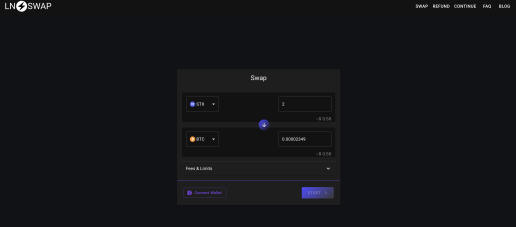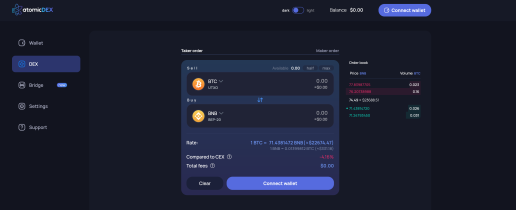As it currently stands, the future of cryptocurrency appears to be a multi-chain world, with many different ecosystems coexisting.
In this likely scenario, the development of cross-chain infrastructure will be critical for connecting siloed blockchains. So far, atomic swap technology has shown promise for revolutionizing decentralized crypto trading.
That’s where atomic swaps come in. Continue reading to learn what atomic swaps are, how atomic swaps work, and why they are important to Bitcoin.
What are Atomic Swaps?
Atomic swaps are peer-to-peer trading mechanisms used for transferring cryptocurrencies across different blockchains without the need for trusted third parties.
This type of trustless swap is an important part of decentralized finance (DeFi) trading. DeFi transactions occur on-chain, without the need for a third party.
Why are Atomic Swaps Important?
Atomic Swaps solve the inefficiencies around exchanging cryptocurrencies through centralized finance (CeFi).
Let’s say for example, you want to swap your ETH on Ethereum to BTC on Bitcoin through a centralized exchange (CEX). This would likely require you to complete a lengthy series of steps, including:
- Creating an account for a centralized exchange platform with an ETH/BTC pairing.
- Sending ETH off-chain to the centralized exchange.
- Converting ETH to BTC (and paying a transaction fee).
- Withdrawing the BTC to a Bitcoin wallet (and paying more fees).
- Finally, waiting for the exchange to process your transaction and for funds to eventually arrive.
This method ultimately results in uneconomical and overcomplicated transactions.
In addition to their inefficiencies, CEXs can present unexpected security concerns with regards to custody.
Centralized trading platforms keep user funds in custodial wallets, with private keys belonging to the exchange. This means that users do not actually have full custody of their assets. In the event of a security hack or freeze withdrawal, your cryptocurrency could be in danger.
Conversely, DeFi can be used with decentralized wallets, where users are the only ones to possess their private keys, and therefore have full ownership over their crypto.
Overall, removing the reliance on “middle-man” for trading eliminates excessive steps and many potential security risks for cryptocurrency users.
In the context of Bitcoin, atomic swaps are extremely important to the rise of DeFi on the Bitcoin blockchain. As we will explore later, atomic swaps are an important way of transferring assets between Bitcoin’s base and its layered solutions.
How Do Atomic Swaps Work?
Atomic swaps use Hashed Time Lock Contracts (HTLCs), a type of smart contract, to facilitate a trustless exchange of digital assets. Smart contracts employ an automated process that self-executes once all predetermined conditions encoded within the contract are met.
Bitcoin atomic swaps are possible thanks to two key components encoded in Bitcoin’s HTLCs:
- Hashlock. A hashlock is a cryptographically hidden key generated by the person that initiated a transaction. This key ensures that swaps are only finalized once both parties approve the transaction.
- Timelock. Timelocks are created as a Check-Lock-Time-Verify command (CLTV) or Check Sequence Verify (CSV). With CLTV, funds within a transaction are locked or released based on date and time. With CSV, funds are locked or released after a certain number of blocks are generated. In simpler terms, timelocks set a deadline for swaps. If both parties do not approve of the swap before a set time, the timelock acts as a safety mechanism and voids the transaction. In this situation, funds will be sent back to their respective owners.
Atomic Swap Example
Let’s examine the steps you would take to exchange ETH for BTC via an atomic swap.
- You generate an HTLC smart contract, deposit ETH (which is locked), and send the contract to the counterparty that has BTC.
- The counterparty confirms your ETH deposit is correct, and deposits their BTC in the smart contract.
- Once the counterparty’s BTC is locked, you can retrieve their BTC, and they can retrieve your ETH.
- If either you or your counterparty fails to retrieve the other’s funds before a set deadline, the transaction is canceled. In this outcome, you would receive your ETH back, and they would receive their BTC back.
Advantages of Atomic Swaps
More interoperability. Atomic swaps open the possibility for different blockchains to be interconnected.
Fully decentralized. Atomic swaps build upon the main objectives of blockchain and cryptocurrency - programmability, immutability, and autonomy. Through smart contracts and blockchain, users are able to retain full custody of their wallet, its private keys, and the tokens held inside.
Inexpensive. By removing intermediaries, atomic swap transactions are relatively cheaper than alternative trading means via a CEX. With some blockchains and layers, fees can be as little as a few cents.
Disadvantages of Atomic Swaps
Newness. Despite their potential, atomic swaps are still somewhat speculative. The existing mechanisms are still in their infancy, which means many of the dApps and their smart contracts have yet to be thoroughly tested for safety and scalability. Moreover, atomic swaps are inherently complex, which slows user adoption. Developers will need to enhance the design and user experience of the atomic swap process to make it seem more accessible and less daunting.
Limited pairings. At this time, there are only a few atomic swap dApps for Bitcoin, with a limited number of compatible assets. Depending on what assets a user wishes to exchange, it may be easier to use a centralized exchange.
Lack of fiat currency trading. Since atomic swaps occur on the blockchain, fiat-to-crypto and crypto-to-fiat swaps are impossible. On the other hand, users may be able to swap for fiat-backed Bitcoin stablecoins.
Atomic Swaps for Bitcoin
Atomic swaps have two main use cases for Bitcoin:
- 1) Interconnecting Bitcoin’s layers
- 2) Connecting Bitcoin to separate blockchain ecosystems.
Let’s take a look at a couple of Bitcoin atomic swap applications.
LNSwap

Source: lnswap.org
A Trust Machines product, LNSwap is an atomic swap protocol that enables trustless swaps between Bitcoin and Stacks, a Bitcoin layer for smart contracts. The LNSwap protocol is compatible with both the Bitcoin base layer and Lightning Network, allowing users to swap BTC and Lightning BTC for STX and other digital assets on the Stacks layer.
Any LNSwap user can provide liquidity by running a client app and contributing funds to join the LNSwap aggregator. Liquidity providers can expect to earn a fee for each swap completed by users.
AtomicDEX

Source: atomicdex.io
AtomicDEX is an multi-coin wallet, bridge, and atomic swap that fully realizes decentralized order matching and trade clearing. Currently, users can access over 500 currencies from dozens of different blockchain networks.
Atomic cross-chain trading with AtomicDEX is quick, simple, and most importantly, trustless. This means that tokens on chains like Ethereum, Binance Smartchain, and Litecoin can easily be directly traded for BTC on the Bitcoin blockchain in just minutes, without the extra hurdles and trading fees with centralized exchanges. Another benefit is that the AtomicDEX allows users to truly own their wallets, always controlling their private keys.
Conclusion
While centralized exchanges can provide a seamless user experience similar to traditional asset trading, atomic swaps provide higher levels of security, immutability, and decentralization. Web 3.0 technology will continue to evolve, with swaps becoming more accessible and promoting more cross-chain interactivity.
Bitcoin is a simple protocol, with limited throughput and programmability. Therefore, Bitcoin must rely on layered solutions far more than other leading blockchains when it comes to incubating an expansive ecosystem of applications. With Bitcoin, it’s important to have a trustless swap protocol like LNSwap that seamlessly integrates the base with its layers. As a result, users can exchange for assets on different layers and interact with various decentralized applications.
Similarly, AtomicDEX is essential for Bitcoin cross-chain interoperability. Having direct, fast, and cheap railways with other blockchain networks like Ethereum gives users another option for bringing more liquidity to the Bitcoin network.
In conclusion, atomic swaps are an up and coming solution for efficient peer-to-peer transactions that help promote the interconnectivity of Bitcoin and the larger blockchain landscape.

